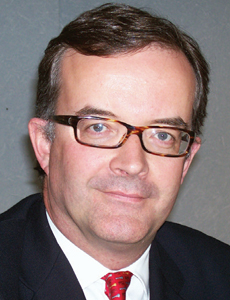Reinsurance Update
Ripe for Reinvention

The global reinsurance market is facing a series of unique challenges, according to the major players in the market who assembled in Monaco for the annual Les Rendez-Vous de Septembre.
The Monte Carlo Rendez-Vous has always marked a key point in the year, as reinsurers, brokers and rating agencies assess where the market stands as it enters the last three months of 2014, especially when it comes to renewals. And there is now a common consensus that the reinsurance market is facing a softening market environment.
James Vickers, chairman, Willis Re International, told Risk & Insurance® that continued softening of the reinsurance market set the overall mood at the Rendez-Vous, with good results and low levels of major claims leading to a plentiful supply of capacity but an increasingly lower level of demand for reinsurance.
“The cost of reinsurance is dropping and there are no positive signs on the horizon,” Vickers said. “The trend is also for more clients looking to retain risk. But some reinsurers are at or near the bottom and if the market softens any more, they and the ILS (insurance-linked securities) investors may well start to walk away.”
According to Vickers, another issue raised at the Rendez-Vous was what amounted to the “tiering” of reinsurers by cedents as they look to consolidate their reinsurer line-up, rating reinsurers according to size, security and breadth of service offering. Bigger beasts like Swiss Re and Munich Re are seen as being in a “premier” division and others in less important divisions beneath them.
In this climate, Vickers said, clients are increasingly looking for added value, asking themselves what, precisely, they’re getting from their reinsurance contracts — not to mention their reinsurers. “Terms and conditions are clearly on the agenda. It’s a legitimate tactic for reinsurers to maintain premium levels by offering broader terms and conditions. They’re being pragmatic,” he said.
“With this background, buyers are being more sensitive when it comes to where they are placing business. They need to be very clear in their minds who their long-term and sustainable reinsurance partners are going to be.”
The state of the reinsurance cycle was also a topic of interest for Swiss Re. Speaking at the Rendez-Vous, Michel M. Liès, chief executive officer of Swiss Re Group, said, “In my 35 years of experience in the business, I’ve seen many turns of the reinsurance cycle and have learned that pricing is only one dimension of it.
In order to succeed, you need to develop your business model based on a deep understanding of market fundamentals, participants’ behaviors and the evolution of your clients’ needs. Rigorous cycle management, portfolio steering and underwriting discipline remain the obvious tools for profitable success. There are opportunities for our industry — especially in high-growth markets.”
Hannover Re agreed about the softening of the market, adding that the pressure on prices, especially in the U.S. natural catastrophe business, has been further exacerbated by the inflow of capital from alternative sources — i.e., the ILS market, which for its part is experiencing substantial cash inflows from pension and hedge funds.
Competitive Pressures
In a statement released just before the event, Hannover Re added, “As a further factor, the protracted low level of interest rates is putting a strain on reinsurers, with pricing discipline taking on particular significance in the face of diminished investment returns. These general conditions are in turn likely — provided the current year is once again spared market-changing major loss events — to shape the treaty renewals as of 1 January 2015.
“Innovative insurance solutions in new areas are the key to long-term profitable growth.” — Torsten Jeworrek, reinsurance chief executive officer, Munich Re
“On the one hand, competitive pressure will therefore probably remain high. On the other hand, reinsurance prices should — leaving aside a few exceptions — stabilize relative to the business renewed for the 2014 underwriting year because scope for further rate reductions is limited in light of the return on equity required by reinsurers.”
In its press conference at the Rendez-Vous, Munich Re announced it believes that there will be a moderate rise in demand for property-casualty reinsurance. In the highly developed markets in Europe and North America — which already have large premium volumes — it anticipates growth of 1 percent in each of the next three years. In Asia-Pacific and Latin America, the growth forecasts are 3 percent and 4 percent, respectively, but starting off from a much lower level, with this growth being fueled partly by increasing market penetration and rising values of material assets, particularly in emerging markets.
Torsten Jeworrek, Munich Re’s reinsurance chief executive officer, stressed that “innovative insurance solutions in new areas are the key to long-term profitable growth.”
According to Munich Re, the environment for the start of negotiations on reinsurance treaty renewals at Jan. 1, 2015 is still dominated by strong competition and extremely low interest rates for investments. Years where losses were relatively low are magnifying pressure on prices.
Jeworrek said, “We provide cover for loss events that do not occur every year, but we need to earn adequate premiums over all those years. In our business, if your thinking is short-term, you pay a high price later.” Munich Re underlined that it intends to stick with its rigorous underwriting policy.
Fitch Ratings’ fundamental outlook for the reinsurance sector is negative due to the softening market. In addition, the onslaught of alternative capital leads it to expect that prices will continue to fall, and that terms and conditions will weaken into 2015 across a wider range of business lines.
Fitch added that price adequacy is expected to decline in 2015, although rates of return are expected to remain above reinsurers’ cost of capital. Earnings pressure is forecast to increase across the sector as softening pricing in property business will migrate to other lines, such as casualty, as reinsurers look to redeploy capital in more profitable areas.
“Persistence of low investment yields increases the risk of adverse investor behavior as both reinsurers and investors seek higher returns,” the ratings agency said in a statement. “The inflow of alternative capital has included select use of hedge fund-based investment strategies, which not only impact balance sheet quality, but are designed to provide a pricing advantage for the reinsurer that can aggravate softening markets.
Long-Term Implications
“Alternative reinsurance and changes in reinsurance purchasing are expected to have long-term implications. The growth of alternative capital is viewed as a credit negative for traditional reinsurers’ ratings, as a significant portion of capital-market funds is expected to remain permanent. Thus, Fitch views the current soft market as not just a normal cycle.”
“Some reinsurers are at or near the bottom and if the market softens any more, they and the ILS (insurance-linked securities) investors may well start to walk away.” — James Vickers, chairman, Willis Re International
Fellow rating agency Standard & Poor’s believes that reinsurers have a continuing role to play in the global economy, but they must find a way to prove their worth to new clients and reinvent their business models to remain relevant in a climate of rapidly changing market dynamics.
It stated that: “Competition from traditional and non-traditional sources in reinsurers’ core markets is forcing them to make adjustments to retain their relevance in a rapidly changing global economy. [We] believe that the traditional reinsurance business model is under threat from external sources, such as corporations and technology companies that could become substitute providers of risk protection. If reinsurers fail to make use of their key strengths and expertise to establish their relevance to new and existing clients, the traditional reinsurers could find themselves marginalized.
“As reinsurance capacity outstrips demand, competition in the global reinsurance market is intensifying. Premium rates declined materially at the major renewal dates in 2014. As reinsurers look to deploy excess capacity, we observe that competition is spilling over from the catastrophe lines of business, and is now weakening pricing in most lines around the globe.”
Rating agency A.M. Best came to a somber conclusion in a briefing note on the global reinsurance market that it released a month before the Rendez-Vous. It stated that: “Given where rate adequacy is, it will continue to take optimal conditions, including benign or near-benign catastrophe years, a continued flow of net favorable loss reserve development and stable financial markets, to produce even low double-digit returns. Such return measures would have been considered average or perhaps mediocre just a few short years ago.
“In our view, companies with diverse business portfolios, advanced distribution capabilities and broad geographic scope are better positioned to withstand the pressures in this type of operating environment, and have greater ability to target profitable opportunities as they arise. It also places increased emphasis on dynamic capital management in order for companies to manage the underwriting cycle and remain relevant to equity investors.”











